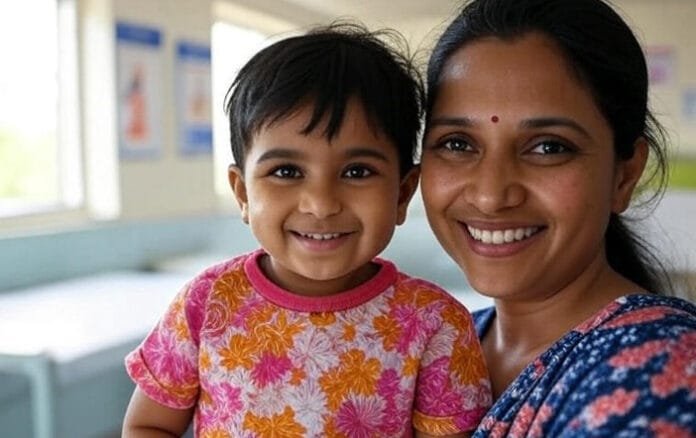India has once again demonstrated its ability to lead on the global health stage, particularly in child immunization. With an annual birth cohort of 26 million, larger than the total population of many developed nations, India has emerged as a model for successful, inclusive, and large-scale vaccination coverage. According to the latest data from 2024, only 0.06% of Indian children remain unvaccinated, placing India far ahead of many high-income countries in immunization outreach.
Mission Indradhanush and Zero-Dose Strategy: Revolutionizing Vaccination Access
India’s remarkable progress is largely credited to robust initiatives like Mission Indradhanush and the Zero-Dose Implementation Plan. Launched in 2014 and accelerated in 2017, Mission Indradhanush has covered 5.46 crore children and 1.32 crore pregnant women, targeting those previously left out of routine immunization schedules.
In 2024 alone, the Zero Dose Implementation Plan focused on 143 high-burden districts across 11 states, aiming to identify and immunize children who had not received even the first dose of DTP (Diphtheria-Tetanus-Pertussis) vaccine. These zero-dose children, under WHO classification, are the most vulnerable. The sharp decline from 0.11% in 2023 to 0.06% in 2024 is a testament to India’s aggressive outreach and targeted interventions.
Digital Tracking with U-WIN Ensures No Child is Missed
One of the cornerstones of India’s immunization success is its adoption of cutting-edge digital tools, particularly the U-WIN platform. This national digital immunization tracking system offers real-time data on vaccination status, ensuring comprehensive monitoring and follow-up. Through U-WIN, healthcare workers can digitally record every vaccine administered and flag children who are due or overdue for any vaccine, dramatically reducing dropouts.
This technology-backed system, integrated with community participation, helps deliver vaccines even in the most remote areas, reinforcing the nation’s commitment to equity in healthcare.
UN and WHO Recognize India as a Global Leader
The United Nations Inter-Agency Group in its 2024 report has officially acknowledged India’s achievements in child health and immunization. The report commends India’s coordinated strategy, emphasizing its reduction of zero-dose children and substantial decline in under-five mortality.
India has recorded a 78% reduction in U5MR (Under-5 Mortality Rate), significantly outpacing the global average of 61%. This outstanding performance directly correlates with increased vaccine coverage, illustrating how effective immunization programs contribute to broader health outcomes.
Community-Level Outreach: Taking Vaccines to the Last Mile
India’s immunization strategy is grounded in its community-level execution. Programs such as Village Health and Nutrition Days ensure that vaccines reach every village and every family. Special vaccination drives like National Vaccination Day and Sub-National Immunization Day continue to support the eradication of diseases like polio, which India has been free from since 2014.
Health workers and ASHAs (Accredited Social Health Activists) play a pivotal role in mobilizing communities, addressing vaccine hesitancy, and providing door-to-door services. Through these efforts, even children in geographically challenging and underserved regions receive timely vaccinations.
Vaccination Success Translates to Reduced Child Mortality
The direct outcome of India’s universal immunization efforts is seen in reduced child mortality and morbidity. Vaccines protect children from life-threatening diseases like measles, polio, diphtheria, tetanus, hepatitis, and more.
According to the UNIGME 2024 report, India’s focused push on immunization has resulted in a noteworthy decline in vaccine-preventable diseases, significantly contributing to the nation’s child survival rate. India’s model showcases how a structured and science-driven public health campaign can produce measurable life-saving results.
Comparing Global Immunization Performance: India Outshines High-Income Nations
Despite the challenges of scale and geography, India’s percentage of unvaccinated children is lower than many developed nations. With only 0.06% of children in the zero-dose category, India performs better than countries with far fewer births annually.
India’s birth cohort of 26 million is larger than the entire population of Australia, New Zealand, Finland, and Switzerland, making this accomplishment all the more significant. While high-income countries often struggle to reach the last mile due to vaccine hesitancy or access issues, India has overcome both through massive awareness campaigns, government backing, and grassroots engagement.
The Road Ahead: Expanding Immunization, Strengthening Health Systems
While the numbers are encouraging, India continues to push forward. The Union Health Ministry has reiterated its commitment to reaching 100% immunization. The goal is not only to sustain the current momentum but to strengthen the health infrastructure, expand vaccine cold-chain systems, and enhance training for health workers.
There are plans to integrate new vaccines into the Universal Immunization Program (UIP) and to continue monitoring coverage and drop-out rates through data-driven dashboards. Continued investment in public health communication, partnerships with NGOs, and greater involvement of state governments are crucial in driving the campaign toward full saturation.
India’s Vaccination Model: A Blueprint for the World
India’s example demonstrates how political will, technological innovation, community participation, and decentralized implementation can produce scalable and sustainable results. As vaccine-preventable diseases decline, India offers a proven roadmap for nations grappling with immunization challenges.
In the coming years, India’s vaccination model is likely to be studied and adopted across Africa, Southeast Asia, and Latin America, especially in regions with difficult terrain, large populations, or limited access to healthcare.
Conclusion: A Global Health Milestone
India’s achievement in reducing the zero-dose child percentage to a mere 0.06% is not just a statistical success—it represents the collective efforts of health professionals, policymakers, community leaders, and millions of citizens. It reflects strategic coordination, operational excellence, and a deep commitment to child health.
In a world still battling healthcare disparities, India’s vaccination success story offers hope and a working formula to ensure that no child, anywhere in the world, is left behind.















